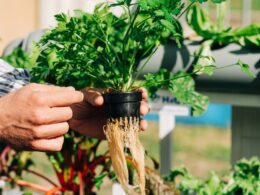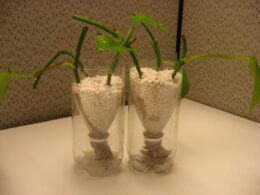Are you curious about the safety of hydroponic produce?
Hydroponics is a method of growing plants without soil, using nutrient-rich water instead. It’s a popular choice for urban farming and sustainable agriculture, but you might be wondering if it’s safe to consume.
Hydroponic produce has some unique advantages, such as faster growth, higher yields, and the ability to control the plant’s environment. However, like all agricultural practices, there are potential risks and concerns to consider.
In this article, we’ll explore the safety of hydroponic produce and compare it to traditional farming methods. By the end, you’ll have the information you need to make informed choices about the food you eat.
Understanding Hydroponics and Its Advantages
Learning about the benefits of hydroponics, you can see how it allows for more efficient and controlled plant growth. Vertical farming, a type of hydroponics, is especially useful in urban areas where space is limited. By growing plants in a controlled environment, you can ensure that they receive the optimal amount of light, water, and nutrients to reach peak growth.
In hydroponics, plants grow in nutrient solutions instead of soil. This method eliminates the need for pesticides and herbicides, making it a safer option for those concerned about consuming harmful chemicals. Additionally, hydroponics uses less water than traditional farming methods, making it more environmentally friendly.
Moreover, hydroponics allows for year-round plant growth, which means that you can enjoy fresh produce even during the winter months. This method also eliminates the risk of soil-borne diseases, making it a safer option for those with weakened immune systems. With hydroponics, you can enjoy fresh, healthy produce without worrying about the safety of what you’re eating.
Potential Risks and Concerns
You might have some concerns about the potential risks of consuming produce grown using hydroponics, but it’s important to know that the method itself is not inherently dangerous.
The main concern with hydroponic produce is the risk of pesticide contamination. Since hydroponics relies on a nutrient solution, pests can easily spread throughout the system if not properly managed. However, many hydroponic farmers use natural pest control methods, such as introducing beneficial insects or using organic pesticides, to minimize the risk of contamination.
Another concern some people have is the potential health hazards of consuming produce grown in a nutrient solution. However, research has shown that hydroponic produce is just as safe to eat as conventionally grown produce. In fact, some studies have found that hydroponic produce may even contain higher levels of certain nutrients due to the precise control over the nutrient solution.
Additionally, hydroponic farming allows for year-round production in controlled environments, which can reduce the risk of contamination from external factors.
Overall, while there are potential risks and concerns with consuming hydroponic produce, these can be mitigated through proper management and safety protocols. By choosing a reputable hydroponic farm that prioritizes safety and sustainability, you can enjoy all the benefits of this innovative farming method without worrying about your health or the environment.
Comparing Hydroponic Produce with Traditional Farming
Let’s take a look at how hydroponic produce compares to traditionally farmed produce! There are many factors to consider when comparing the two, but one major difference is the nutritional benefits.
Hydroponic produce is often grown in a controlled environment with nutrient-rich solutions, which can lead to higher levels of vitamins and minerals. Traditional farming, on the other hand, relies on soil quality and weather conditions, which can vary greatly and affect the nutrient content of the produce.
In addition to nutritional benefits, the environmental impact of hydroponic farming is also worth considering. Hydroponic systems use significantly less water than traditional farming methods, as the water is recirculated and reused. This means less strain on water resources and a reduced risk of water pollution from fertilizer runoff.
Hydroponic farming also eliminates the need for pesticides and herbicides, as the controlled environment and lack of soil greatly reduces the risk of pests and diseases.
Overall, while there are some concerns and potential risks associated with hydroponic farming, it’s generally safe to eat and can offer various benefits compared to traditional farming. By providing higher nutritional value and reducing environmental impact, hydroponic farming’s becoming an increasingly popular option for those looking for safe and sustainable produce.
What Are the Health Benefits of Eating Hydroponic Food?
Hydroponic food health benefits encompass various advantages. Firstly, consuming hydroponic food ensures a higher nutrient density, as the plants receive optimal nutrition throughout their growth. Additionally, hydroponic farming methods eliminate the need for pesticides, reducing the risk of chemical exposure. Moreover, hydroponic systems conserve water, making them environmentally sustainable. Lastly, these practices promote year-round food production, providing fresh produce regardless of seasonal limitations.
Regulations and Standards
Now we’ll dive into the rules and guidelines that regulate the production and sale of hydroponic produce, ensuring quality and transparency for consumers. The certification process for hydroponic produce is similar to that of traditional farming. However, the government oversight of hydroponic farming is relatively new and differs from state to state.
To ensure the safety of hydroponic produce, the United States Department of Agriculture (USDA) has established a National Organic Program (NOP) that sets strict standards for the production and sale of organic foods, including hydroponic produce. The NOP standards require that hydroponic growers use only approved substances for pest and disease management and that they maintain soil fertility through crop rotation or other approved practices.
Here’s a table that compares the regulatory requirements for hydroponic produce and traditional farming:
| Regulatory Requirements | Hydroponic Produce | Traditional Farming |
|---|---|---|
| Soil Testing | Not Required | Required |
| Water Testing | Required | Not Required |
| Nutrient Management | Required | Required |
| Pest Management | Required | Required |
In conclusion, hydroponic produce is safe to eat as long as it meets the same regulatory requirements as traditional farming. The certification process and government oversight ensure that hydroponic produce is grown and sold with transparency and quality in mind. The USDA’s NOP sets strict standards for organic hydroponic produce, including the use of approved substances for pest and disease management, and maintaining soil fertility through crop rotation or other approved practices.
Making Informed Choices
When deciding what produce to buy, it’s important to be informed about the regulations and standards that govern its production and sale. This is especially true when it comes to hydroponically grown produce.
While hydroponics is generally considered safe, there are ethical concerns and potential environmental impacts to consider. One of the ethical concerns with hydroponics is the use of synthetic fertilizers and pesticides. These chemicals can be harmful to both the environment and the consumer. However, many hydroponic growers have switched to organic methods, which eliminates these concerns. It’s important to do your research and find out how the produce was grown before making a purchase.
Another potential environmental impact of hydroponics is the amount of energy needed to grow the produce. Hydroponic systems require artificial lighting, heating, and cooling, which all use energy. However, some growers are using renewable energy sources, such as solar power, to minimize their impact. Again, it’s important to ask questions and make informed choices.
In summary, while hydroponics is generally safe to eat, it’s important to consider ethical concerns and environmental impacts when making purchasing decisions. By researching the growing methods used and asking questions, you can make informed choices to ensure the safety and sustainability of your food choices.
Frequently Asked Questions
How does hydroponic produce compare in taste to traditionally farmed produce?
When it comes to taste comparison, hydroponic produce can be just as delicious as traditionally farmed produce. Some hydroponic farmers argue that their produce tastes even better due to the controlled environment in which it grows.
As for nutritional value, hydroponic produce can have just as much, if not more, nutrients than traditionally farmed produce. Because the plants are grown in a nutrient-rich solution, they can absorb the exact amount of nutrients they need to thrive.
So, when it comes to taste and nutritional value, hydroponic produce can hold its own against traditionally farmed produce.
Can hydroponic farming be done on a small scale for personal use?
Looking to grow your own produce? DIY hydroponic systems offer a great option for small-scale farming. It’s easy to set up and maintain, and homegrown hydroponic produce comes with a host of advantages.
For one, you can control the nutrients your plants receive, which translates to healthier, tastier produce. Growing your own food means you know exactly where it’s coming from, and you can rest easy knowing it’s safe to eat.
So why not give hydroponic farming a try and enjoy the benefits of homegrown, fresh produce right at your fingertips?
Is hydroponic farming environmentally sustainable?
Are you curious about the environmental sustainability of hydroponic farming? Let’s explore the impact of water usage and energy consumption in this innovative farming method.
Hydroponics uses significantly less water than traditional soil-based farming, making it a more sustainable option in areas with limited access to water. However, hydroponics requires high energy consumption for lighting, heating, and cooling systems, which may offset the benefits of reduced water usage.
When weighing the pros and cons of hydroponics versus soil-based farming, it’s essential to consider the long-term sustainability of each method. Overall, hydroponics offers a promising solution for sustainable agriculture, but it’s crucial to continue exploring ways to minimize its energy consumption and environmental impact.
What types of crops are best suited to hydroponic farming?
When it comes to hydroponic farming, certain crops are better suited than others. Vertical farming is ideal for growing leafy greens, herbs, and small fruits like strawberries. These crops thrive in nutrient solutions, which are carefully controlled to ensure optimal growth.
Additionally, hydroponic farming can be done indoors, making it possible to grow crops year-round regardless of weather conditions. While the safety of hydroponically grown produce may be a concern, it’s important to note that proper food safety protocols are followed in this type of farming just as they are in traditional farming methods.
How does the cost of hydroponic produce compare to traditionally farmed produce?
When it comes to the cost of produce, it’s important to consider the benefits that vertical farming and hydroponics can bring.
By growing crops in a controlled environment, there’s no need for expensive pesticides or fertilizers, making the overall cost of production much lower.
Additionally, vertical farming can produce a higher yield in a smaller space, which means less transportation costs and a smaller carbon footprint.
While organic certification may add an additional cost, it’s important to consider the benefits of knowing exactly where your food comes from and how it was grown.
Overall, the cost of hydroponic produce can be comparable to traditionally farmed produce, especially when you factor in the added benefits of safety and sustainability.
Conclusion
So, is hydroponics safe to eat? The answer is yes, but with some precautions.
Hydroponics provides a sustainable and efficient method of growing produce, but there are potential risks and concerns that need to be addressed. It’s important to compare hydroponic produce with traditional farming and to be aware of regulations and standards in order to make informed choices.
When purchasing hydroponic produce, look for products that’ve been certified by reputable organizations and follow proper food safety protocols. It’s also important to thoroughly wash and inspect all produce before consuming.
By understanding the advantages and potential risks of hydroponics, you can make informed choices and enjoy the benefits of this innovative farming method.








